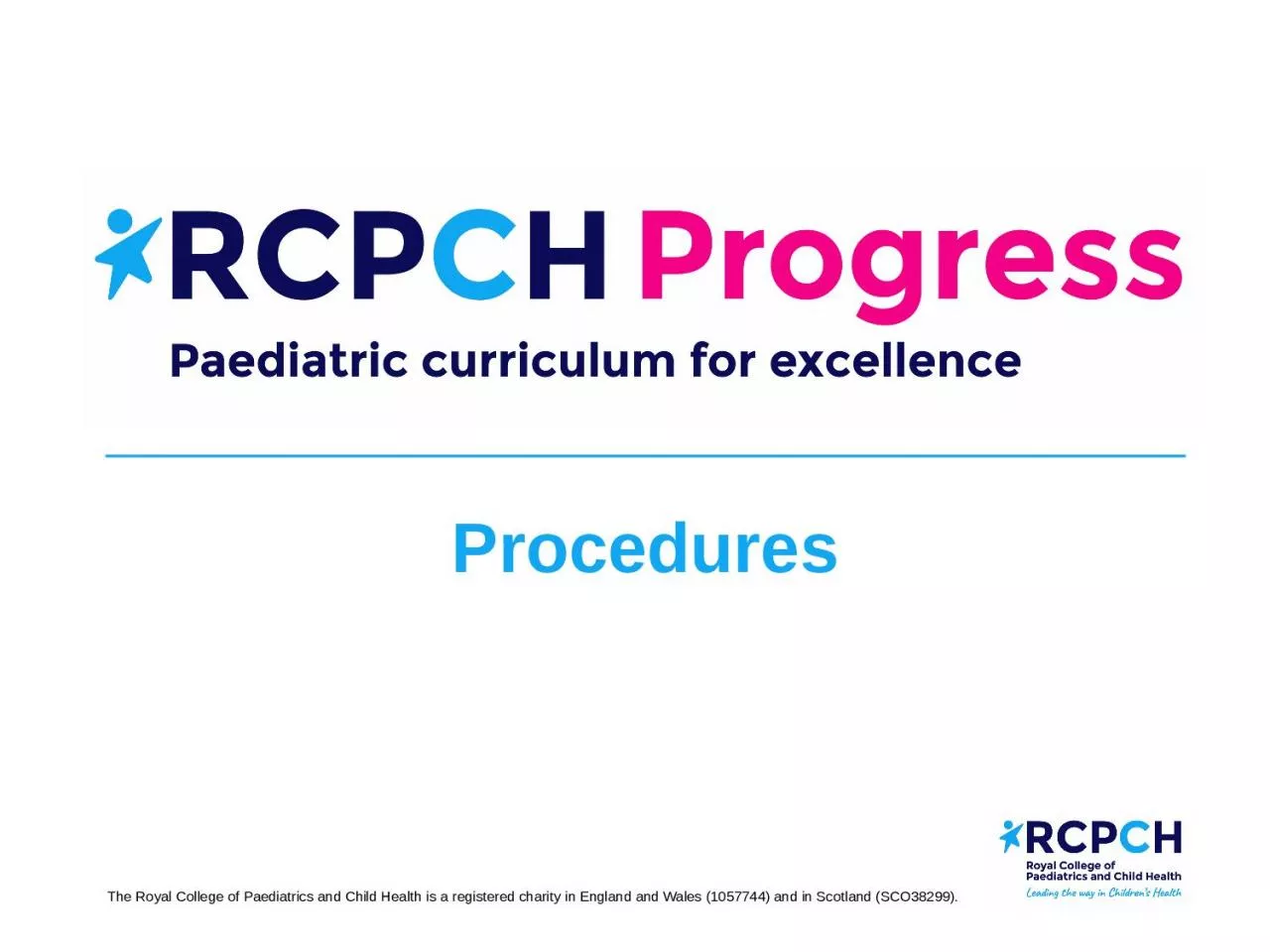

Key capabilities Level 1 Adapts clinical examinations to meet the needs of the child and family or carers undertaking basic paediatric clinical procedures Recognises emergency situations knowing when and how to escalate appropriately initiates basic life support and carries out advanced lif ID: 1038971
Download Presentation The PPT/PDF document "Procedures Learning outcome" is the property of its rightful owner. Permission is granted to download and print the materials on this web site for personal, non-commercial use only, and to display it on your personal computer provided you do not modify the materials and that you retain all copyright notices contained in the materials. By downloading content from our website, you accept the terms of this agreement.
1. Procedures
2. Learning outcomeKey capabilitiesLevel 1Adapts clinical examinations to meet the needs of the child and family or carers, undertaking basic paediatric clinical procedures.Recognises emergency situations, knowing when and how to escalate appropriately; initiates basic life support and carries out advanced life support with guidance.Performs appropriate clinical examinations of a baby, child and young person.Demonstrates that they have achieved both basic and advanced life support skills.Undertakes key procedures including the following:Peripheral venous cannulaLumbar punctureAdvanced airway support, including tracheal intubationUmbilical venous cannulationLevel 2Supervises and assesses junior staff when undertaking clinical procedures; responds to and leads emergency situations, and performs advanced life support.Ensures the correct placement of arterial and venous access.Supervises and assess junior staff undertaking clinical procedures.Responds to and leads emergency situations, and performs advanced life support.Level 3Demonstrates competence in the full range of clinical skills relevant within paediatrics and either general paediatrics or their chosen sub-speciality.Utilises the skills of other health professionals when required.Maintains skills at the level of competency.Curriculum overview
3. Underpinning knowledge
4. Learning to competently and compassionately perform procedures is one of the hardest skills in paediatrics.Acquisition of skills is a continuum from novice to expert.Developing the skills to competently teach as well as perform procedural skills is an important part of training.Procedures
5. Dreyfus Model of Skill AcquisitionAdapted from Dreyfus and Dreyfus,1980
6. Right procedure, place, time and patient.Right people – Supervision, Senior help if required, play specialist, assistant.Consent – is it needed? Have you informed the parents / patient of the procedure.Check equipmentAnalgesia/Distraction aidsImportant blood results – e.g. LP – check platelets.Things to consider for every procedure
7. Directly observed procedures – Best done at the time with contemporaneous feedbackSkills log – Keep a contemporaneous log of skills competence including supervising othersReflective log – Part-task simulation and Resuscitation coursesMini-CEX – Demonstrating clinical examination of a baby, child or young person or basic resuscitation skillsACAT – Observed leading resuscitation in ED/Labour WardMini-CEX/CBD – For the senior supervising or teaching the procedureHow to evidence
8. Revise relevant clinical knowledgeSafe use of equipmentLearn the procedural stepsPractice outside clinical environment – e.g. part task simulation/mannequinsPerform supervised procedures with feedbackPractice in a variety of different contexts/ situations/age groupsMaintain capabilitySteps for learning a new procedure
9. Revise the relevant clinical knowledgePaediatric airway anatomy, watch some videos to understand clinical anatomy – before you pick up a laryngoscope!Understand the steps of the procedure and be able to safely use the relevant equipment. Example – Advanced Airway Management
10. Before you do your first intubation get someone to supervise you using a mannequin and give you feedback on positioning and laryngoscopy technique.Pre-patient training
11. Preparation, preparation, preparation – if your department has an intubation checklist use it. Another great way to get experience is to arrange to shadow an anesthetic colleague.For more advanced airway management you can attend a difficult airway course in your region.Further practice
12. Identify what you need to practice - Put yourself forward for procedures to the clinical team coordinator and the procedures you would like to gain competence inBe proactive with learning opportunities e.g. organizing anesthetic room experience for airway managementAsk for feedback when leading resuscitation scenarios in EDProcedural top-tips
13. Peyton’s 4 Stage ApproachTeaching procedural skillsAdapted from Peyton 1998
14. Kolb’s Experiential LearningTeaching Procedural SkillsAdapted from Kolb 1984
15. Useful training and resourcesRCPCH Progressing Paediatrics course: Paediatric Emergency MedicineRCPCH How to Manage courses - a sample of forthcoming events shown belowhttps://www.rcpch.ac.uk/education-careers/courses/rcpch-course?keywords=how+to+manage
16. Useful WebsitesResuscitation Council https://www.resus.org.ukSpotting the Sick Childhttps://spottingthesickchild.comPaediatric Emergencies – Great resource with lots of resources and videos for intubationhttps://www.paediatricemergencies.comThe Difficult Airway Society - https://das.uk.com
17. Paediatric FOAM website – useful resources for ventilation managementhttps://www.paediatricfoam.comCranial Ultrasound Standard Viewshttp://www.adhb.govt.nz/newborn/TeachingResources/Radiology/HUSS/NeonatalHUSSViews.htmMRCPCH Clinical Examination Websitehttps://mrcpch.paediatrics.co.ukUseful Websites
18. Great videos and lectures for intubation and management of the sick childhttps://www.youtube.com/channel/UCULr4Ved30fymSHoxeweJHgPercutaneous Long line insertion from Evelina Children's HospitalCentral Line insertion from PICU at GOSHhttps://www.youtube.com/watch?v=7KjjJVFdbC0Neonatal Procedures from MPROvehttps://www.youtube.com/channel/UC22LMIG5Bwqhreic_DFHATwPaediatric Anaestheisa and Airway Managementhttps://www.youtube.com/channel/UC4B28Tt4K6hc4tJ239CLS_QUseful Videos
19. Neomate – useful measurements for Endotracheal tube size and length and Umbilical lineshttps://itunes.apple.com/us/app/neomate-for-nicu-staff/id944319462?mt=8Useful Apps
20. Dreyfus SE, Dreyfus HL. A five-stage model of the mental activities involved in directed skill acquisition. California Univ Berkeley Operations Research Center; 1980.Walker M, Peyton JW. Teaching and Learning in Medical Practice. Heronsgate Rickmansworth, Herts: Manticore Europe Ltd; 1998. Teaching in the Theatre; p. 171–180.Kolb D. Experiential education: Experience as the source of learning and development. Englewood Cliffs, NJ. 1984.Harden RM, Laidlaw JM. Essential skills for a medical teacher: an introduction to teaching and learning in medicine: Elsevier Health Sciences; 2016.(3)References